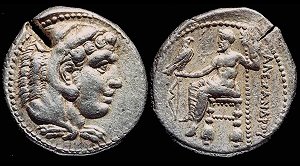Münze Alexanders des Großen
Vs.: Kopf des Herakles nach rechts (s. Text unten!),
Rs.: thronender Zeus nach links, mit der Linken gestützt auf ein Zepter, auf
der ausgestreckten Rechten den Adler, darunter Bogen, rechts
Inschrift "Alexand..." in Griechisch.
Quelle der folgenden Angaben und Bilder: http://dougsmith.ancients.info/

Alexander III (the Great) - 336-323 BC (lifetime issue?) Bow in field -
Salamis mint? - test cut 17.2g, 25mm
This earlier (most likely 'lifetime') tetradrachm was struck on a thick,
chunky flan and shows the legs of Zeus parallel. There is no letter to
identify the mint but assignments have been made based on style and other
research data published in Price and other references. Not all sources will
agree with every attribution. The 'minor type' is a bow in the left field and
the legend is limited to the name Alexander.
The obverse of 'Alexander' coins show the head of Herakles wearing a lion
skin while the reverse has Zeus seated holding an eagle. Issues are
distinguished from one another by letters or symbols placed in the reverse
fields or under Zeus' throne. The only coins of this type that I have seen
that do NOT have these 'minor types' or field letters have been barbaric or
unofficial (though ancient) copies. Early or 'lifetime' issues usually are
struck on thick, chunky flans and show the legs of Zeus parallel to each
other. Most later coins used a wider, thinner flan and show Zeus with legs
crossed at the ankles. These rules are not 100% reliable and exact
attribution of all of these various coins is very much open to further study.
Recent (1991) publication of Martin Price's great work on the subject, The
Coinage in the Name of Alexander the Great and Philip Arrhidaeus, has
provided collectors with much information and a catalog of known types but
the cost of the book will keep it from being owned by most collectors.
Similarly, the coins themselves are not low priced. Attractive large silver
tetradrachms are popular among coin collectors and for the jewelry trade.
While there are probably hundreds of 'Alexander' coins available for each
person who collects, there are certainly individual varieties that are quite
rare.